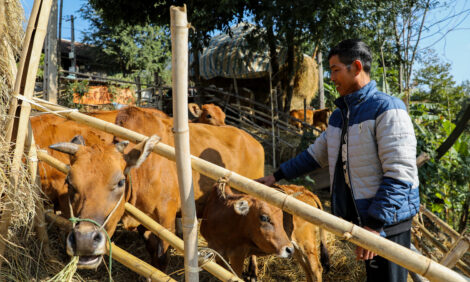



The Advantages Of Yard Weaning Calves
This fact sheet produced by Meat and Livestock Australia compares yard and paddock weaning of calves, including how to successfully wean and the advantages and costs involved.Australian trials show yard weaned calves have superior weight gain over the first three months and a lower incidence of respiratory disease compared to traditional paddock weaned animals.
Anecdotal evidence from trials on Gisborne beef farms shows that interaction with humans during the critical weaning period can produce quieter animals. Despite higher feed and labour inputs required, there may be significant gains from holding and feeding calves in a yard for five to seven days.
Why yard wean
The idea of yard weaning is to get calves used to humans and minimise stress during weaning. This results in:
- Cattle that are easier to handle over their lifetime.
- Reduced chance of damage to people or equipment.
- Increased chance of superior early weight gain.
- Cattle that are likely to adjust more quickly to feedlot or cell grazing systems, improving the chance of superior weight gain.
How to yard wean successfully
Timing: When ready to wean, separate calves from cows. Wean calves into a yard for between five and seven days.
Yard: Use well-built solid pens. The ideal structure is solid opaque pen sides made from 1.2m rubber belting. The yard soil should be firm, not boggy.
Density: For calves between 180kg and 260kg allow at least 4m2/head. For smaller calves (under 180kg) allow 2.5m2/head. It is important to have calves yarded fairly close together as it quietens them down more quickly.
Feed: Always have both water and feed available and ensure feed is high quality (e.g. silage or hay over 9.5 mega joules of metabolisable energy (MJME)). The feed should be raised off the ground e.g. in a round bale feeder and separated from the water to prevent spoiling. Ideally have the feed and water a short walk away from each other. The younger the calves the better the quality of feed required.
Australian daily nutritional recommendations for feed energy levels for newly-weaned calves are:
- At 3-6 months calves need 10.9 MJ/kg DM .
- At 6-12 months calves need 10.3 MJ/kg DM.
- Calves over 12 months need 9.5 MJ/kg DM.
Dry concentrate supplements (e.g. grain) may be required to boost energy in the diet if hay/silage/baleage is of low quality. Introduce concentrates slowly, building up to maximum daily amount. For more information see Early Weaning of Beef Calves, Agriculture Notes, 2008, Victoria, Australia, posted at www.dpi.vic.gov.au.
Cud chewing is a sign of good rumen health. Aim to have 50 per cent of calves that are not actively eating, chewing their cud.
The ideal dung pat can be trailed out with your foot yet does not have visible straw fibres. Bubbles in manure indicate poor rumen health and poor fermentation.
Training: To socialise the animals, have at least one person walk through the yards at least twice a day. Avoid using dogs.
Animal health: Monitor for disease, especially pink eye if yards are dusty.
Australian experiences
An Australian trial in 1997 compared the performance of calves over three years in a feedlot that were either:- paddock weaned
- yard weaned with minimal handling
- yard weaned with extra handling and grain feeding
Results showed that yard weaned calves had higher weight gain over the first month of feeding and over 90 days than paddock weaned calves. The extra training in eating grain from troughs was not necessary to get the growth rate advantage.
Yard weaned calves were 15kg liveweight ahead after the first 90 days
Paddock weaned calves averaged 1.28kg/head/day while yard weaned calves grew at 1.45kg/head/day for the first 90 days on feed. The ‘extra-handling’ yard weaned calves grew at 1.41kg/head/day.
The extra handling involved running calves from one small yard to another and back at least once a day.
Gisborne-Wairoa farm trials
Through funding from Meat & Wool New Zealand, five farms in Gisborne-Wairoa trialed yard weaning. The farmers were all members of the Beef Profit Partnership (BPP) that was created to lift returns from beef.
Grant Hickling’s farm trial
At the Hickling farm calves were split into two groups and weighed both before and after the yard weaning trial. The trial period was 6.5 days. Cows were removed to another part of the farm. Calves were Angus/Hereford/Simmental cross and were weaned at approximately 140 days old (4.5 months).
Yard weaned calves were fed seven bales of silage (total $595) and needed three hours of labour (total $75). This gave a per head cost for the total yard weaning period of $8.93/head.
Results
The yard weaned calves gained more weight than the paddock weaned calves, over the 6.5 day trial. The yard weaned calves gained 10kg compared to 0.5kg for the paddock weaned calves.
Table A: Hickling paddock versus yard weaning trial, Gisborne, 2008.
| PADDOCK WEANED | YARD WEANED | |
|---|---|---|
| Number of calves | 125 | 75 |
| Average weight at start | 171.5kg | 156.5kg |
| Area | 5ha | 2.4m2/head |
|
Average gain/hd/day (over 6.5 days)
|
0.08kg
|
1.53kg
|
| Average liveweight added over 6.5 day trial | 0.5kg | 10kg |
| Total cost | - | $670 |
| Cost/head | - | $8.93 |
| Cost/kg LW gain | - | $0.90 |
Mark Munro’s farm trial
Mark Munro was another BBP farmer who undertook a calf weaning study. He yard weaned 40 calves (at approximately 150 days old), into a yard for 12 days. Hay and silage was fed from a rack twice a day, morning and night. Water was provided. If the fed was all eaten, the allowance was increased the following day.
Another 40 calves were weaned in the traditional manner – on to a large hill paddock without any supplementary feed. After 12 days the yard weaned calves were tagged then mobbed together with the paddock weaned calves. Calf weight and quietness was assessed over time.
Calves were weighed on the same scales and at the same time. Paddock weaned calves were full at weighing and yard weaned calves emptied out over lunchtime. The calves were either traditional or exotic breeds.
Results
At 11 days post-weaning the paddock weaned calves had gained more liveweight than the yard weaned calves (20kg versus 15kg). Mr Munro puts this down to yard weaned calves having average quality silage.
Table B: Munro paddock versus yard weaning trial, Gisborne, 2008.
| PADDOCK WEANED | YARD WEANED | |
|---|---|---|
| Number of calves | 40 | 40 |
| Average weight at start | 168 kg | 164 kg |
| Average weight after 12 day trial | 188kg | 179kg |
|
Weight change
|
20kg
|
15kg
|
| Average gain/day | 1.7kg | 1.3kg |
He believes the slower weight gain would have been corrected if the hay/silage was of better quality, e.g. lucerne.
At 73 days post-weaning the yard weaned calves had caught up however, and both groups weighed 207kg LW on average. From day 11 to day 73 the yard weaned calves had gained 20kg while the paddock weaned calves gained 10kg. They had been on a rotational grazing system, with shifts every 3.5 days.
Mr Munro observed the yard weaned calves were noticeably friendlier than the others. “They just about sniff your hand when you’re feeding them. This was despite choosing the flightier calves to go into the yard weaned group.” They have continued to be quieter over the following year when they were run together, according to Mar’s observations. However he also believes that yard weaning some of the calves has improved the temperament of all the calves.
Mark believes that yard weaning is a good strategy for bull calves. He believes 12 days is too long however. This season he will hold calves for eight days, with a targeted feed cost of $15/head. Mark will wean when weather forecasts predict a dry spell. The farm has high rainfall (2m/year) and yards can become boggy. A concrete pad to wean calves onto would be ideal.
Advantages and costs
Higher weight gain in first month
Research by Australia’s Beef CRC (Cooperative Research Centre) shows that yard weaned cattle compared to paddock weaned cattle typically had higher weight gain in both the first month and over the first 90 days.
Improved temperament
Yard weaning is common practice in Australia because of feedlot requirements and because Brahmin breeds typically have ‘poorer temperaments’ than British breeds. However, trials show the temperament of all cattle improves with good yard weaning as calves.
Fewer respiratory diseases
A 1997 Australian trial showed that yard weaned calves had half the disease rate of paddock weaned calves.
Cattle are more likely to suffer from respiratory disease if they are stressed.
Australians recommend vaccinating feedlot calves against respiratory diseases.
Early weaning aids flexibility in feed deficit situations
In very dry seasons, yard weaning with supplementary feed allows calves to be weaned earlier, e.g. at 12 to 14 weeks of age. If cows aren’t suckling a calf they drink less water and are more likely to gain weight and get in calf. Their body condition score is more easily maintained over a feed-short summer.
Worth feed and labour inputs
The 1997 Australian study showed that over 90 days, the extra growth from yard versus paddock weaning easily paid for the extra feed and labour costs.
Australian feedlots prefer to buy yard weaned cattle and cohorts of animals that have been weaned together.
Summary
Yard weaning offers weight gain and handling advantages over the lifetime of the cattle beast.
Yard weaned and trained cattle are likely to be more sought after for finishing than cattle with unproven backgrounds.
Acknowledgements and more information
Beef Profit Partnership farm groups are funded by Meat & Wool New Zealand. Their focus is to increase beef profitability by 5 per cent each year for each farm, within two years of joining the BPP.
For more information on yard weaning see the Beef Cooperative Research Centre “Science for Quality Beef” booklet. Visit www.beefcrc.com.au and go to Publications.
For nutrition information see Early Weaning of Beef Calves, Agriculture Notes, 2008, Victoria, Australia, posted at www.dpi.vic.gov.au


